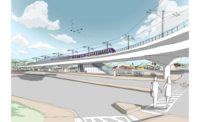Maryland’s $2-billion Purple Line light rail project has prevailed in the third and likely final attempt to block the new transit system currently under construction across Washington, D.C.’s northern suburbs.
U.S. District Judge James K. Bredar on April 13 rejected claims by a non-profit organization and two residents that the U.S. Army Corps of Engineers violated the federal Clean Water Act by allowing construction-related dredging and other work in streams and wetlands without fully considering other options to improve mobility along the project’s16-mile route.
Bredar also wrote that the Maryland Transit Administration, which defended the lawsuit on behalf of the Corps, “clearly demonstrated” that the final design was the “least environmentally damaging practicable alternative.” The agency will be required to perform stream restorations and wetlands creation to mitigate construction impacts.
Intended to provide an alternative to the congestion-prone I-495 Capital Beltway, the Purple Line has long encountered opposition by groups and individuals critical of the project, which is being built as a public-private partnership by a team led by Fluor, Lane Construction and Traylor Brothers.
A federal lawsuit claiming faults with the Purple Line’s environmental analysis delayed the planned 2016 start of construction by more than a year before finally being rejected.
A second federal lawsuit, filed in 2018 by the same plaintiffs, unsuccessfully asserted that federal transit officials awarded the Purple Line $900 million in New Starts funding without fully considering the impact of declining ridership on the Washington, DC, area’s Metrorail system on the project’s financial structure. Transfers between the two systems are projected to provide nearly 30% of the Purple Line’s ridership.
While unsuccessful, the three lawsuits have complicated the Purple Line’s construction schedule, with only the easternmost five-mile segment scheduled to be ready by the original March 2022 completion date.
The remaining 11 miles, located in a more densely developed suburban area, will require at least another six months to finish.

